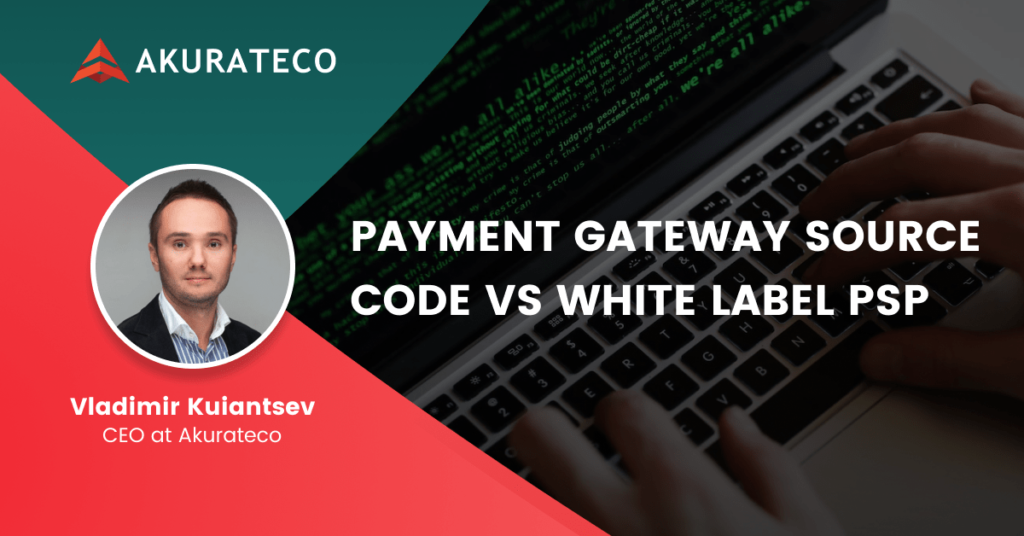
The complexity of payment technologies increased dramatically within the last decade. ApplePay, GooglePay, tokenization, crypto-payments, QR-code payments, and plenty of other flows and features are currently in a high demand. Moreover, new features and payment methods are constantly emerging and this trend will only grow. At the same time entrepreneurs worldwide want to leverage business opportunities in the fintech industry to stay ahead of the competition.
Launching a tech company you always have two choices. Either you own the software or rent it (SaaS or On-premise). It may be challenging to decide what to choose for your business. Both payment gateway source code and a white-label PSP have their pros and cons, and the decision-making might seem an impossible task.
That is why in this article, we’ll look at both these choices and help you decide what works best for your business and meets all of your specific needs.
Payment gateway source code: Undeniable pros
- Total control.
With the payment gateway source code, you get total control over the program code and all the processes. This means reduced security risks and elimination of data breaches. Besides, by having full control over the code, you also get a chance to customize it to your specific needs. You are free to fine-tune the software to meet the legal requirements within your local jurisdiction or make any other tweaks to accommodate the needs of your end user. - No need to hire external contractors.
The source code solution calls for in-house development. You are getting full access to the code and, thus, can now change it to your heart’s content. With this solution, you are solely responsible for its installation, maintenance, and refactoring. This gives you freedom from any external contractors but also places full responsibility on your company. - Development speed.
If along the way you realize that you need additional functionality to meet your business needs, you are free to develop it exactly the way you need it and start the development process right away. In-house development translates into an increased speed and better understanding of the specific requirement for the new features, both of which are undeniable benefits of source code solutions. - Unlimited customization.
Owning the source code allows you to customize it so that this software is everything you ever wanted it to be. New features, documentation, new payment methods, or connectors – you can add them all, no questions asked, using your in-house team.
These benefits are hard to beat. Yet, as with any solution, source code comes with a range of cons you can’t afford to miss. So, let’s look into those as well.
Payment gateway source code: Important cons
- Solution cost.
Let’s start with the most significant disadvantage of this solution – its cost. Full customization, development speed, and total control over the code all add up, bringing the cost of the solution to hundreds of thousands of dollars. While this might be a fair price for enterprise customers and clients from specific regions with legal requirements that would only allow for this sort of solution, if you’re just starting your PSP business, you might want to consider a different solution. - IT support cost.
Again, the cost. This time we’re talking about the cost of IT support for the solution. Since you’re solely responsible for the maintenance of the payment gateway, the cost of its support is 100% on you. To maintain it, you will need to hire an entire IT department. With an average developer’s salary ranging between $6K and $10K, you are looking at a $40-50K monthly salary fund for a team consisting of several developers, QA specialists, DevOps, system administrators, and security managers. - Long time-to-market.
Last but not least, you need to bear in mind that this solution takes up to several months to launch. Not only does the team need time to study the source code and sort out the infrastructure, but also to deploy this code, test it, and ensure it’s up to the top industry security standard by obtaining a PCI DSS certificate.
Now, these are the main pros and cons of the payment gateway source code solution. If you are not sure it’s right for your business, let’s look into the white-label solution.
White-label payment gateway: Pros
- Lower cost.
With a white-label payment gateway, you are looking at lower costs. Thanks to the fact that you’re buying a ready-made solution, you are not paying for the development and, thus, are saving a fortune. This way, instead of hundreds of thousands of dollars, you can get access to a payment gateway for some $6K/month. If you are a new business, this solution, with its cost-effective approach, can be a way to go. - Faster go-to-market time.
By purchasing a ready-made solution, you are getting a chance to get a few steps ahead of your competition by starting early. All you need is to tweak the system a little to adjust it to your needs – and it’s ready to go. Unlike the source code option, you don’t need any major development here. And so, once you get it installed, you can start onboarding your customers to the system. - Hundreds of ready-made payment connectors.
With new payment methods emerging daily, you will need hundreds of them available on your platform to meet the needs of your diverse clientele. Luckily, if you choose a white-label solution, you can access hundreds of payment methods immediately. The thing is that white-label payment service providers cater to a variety of vendors, and to meet their needs, they constantly add new payment connectors. So, chances are the methods you need are already on their list. And if not, within days, they can add them to the platform for you: after all, they’ve got extensive experience adding new methods and have a whole IT department on standby, ready to help you. - Lower maintenance cost.
A white-label solution provider will act as your in-house tech support team. They will help you fine-tune and maintain the system as well as implement specific features you find missing. Hiring such a team of seasoned professionals will cost you thousands of dollars in the monthly salary fund. However, if you go with a white-label provider, you are shaving this money off your budget.
To maintain full transparency, we’d like to look into the white-label payment solution’s cons. While the pros surely outweigh them, they’re still significant enough to consider.
White-label payment gateway: Cons
- Migration.
Once you choose a white-label payment gateway, it is difficult to switch providers and migrate data from one platform to another. We are not saying it is impossible, but a secure migration process will take months of hard work. Therefore, we insist you weigh all pros and cons before settling so as not to lose precious time later in the painstaking migration process. - No direct access to the source code.
While white-label payment gateways do allow certain customization, you’re purchasing a ready-made solution, meaning that you won’t be able to revamp the system completely to facilitate your specific needs. If you are to comply with specific regulations or local jurisdiction, white-label might not be the right choice for you.
Akurateco is offering both of these options at a top-of-the-industry level of quality. Therefore, no matter which solution you choose, we’ll be there every step of the way, helping you launch and maintain the system and add your first customers to the platform.
We’re fully committed to easing you into the process by:
- Helping you choose the right infrastructure;
- Explaining in detail how to use the source code right;
- Obtaining a PCI DSS certificate for your platform;
- Maintaining the product in the early stages.
With more than 15 years of experience in the industry, we’re here to provide you with expert assistance before and after you select the best-fitting model for your business. If you’d like to get started, we’re offering a free Demo of the system so that you can get a taste of how it works and what benefits it offers to you and your customers.









